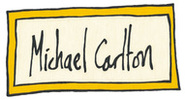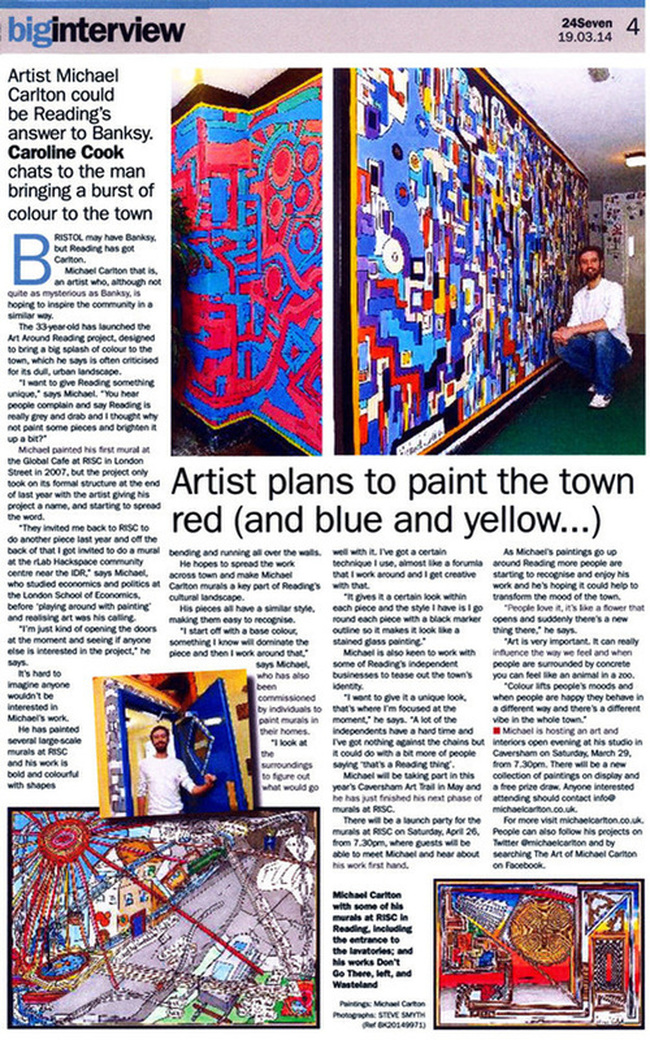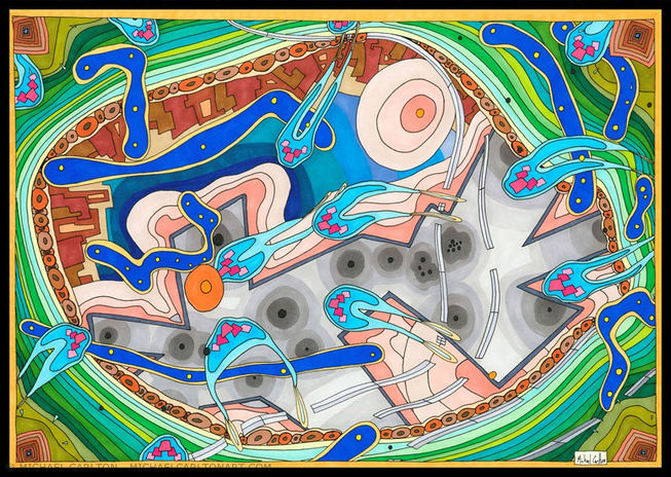Press
"Bristol may have Banksy, but Reading has got Carlton"
- Caroline Cook, Reading Post
- Caroline Cook, Reading Post
Caversham Primary School Receives Mural from Reading Artist as
part of his Art for the Schools Project
part of his Art for the Schools Project
by Mary Naylor
Reading's answer to Banksy, Michael Carlton, is inspiring school children with his latest project Art for the Schools.
Michael has just finished his first placement at St Anne’s Catholic Primary School in Caversham where he painted a 4.5m square mural on one of their corridor walls.
His Art for the Schools project aims at giving children the chance to meet and question a professional artist and to help them explore their own creativity.
The idea grew as a collaborative effort between Michael, teacher Maria Glenister, Janice Brown, the head of school and the executive head, Margot Buller.
Mr Carlton said: “The school itself had been having some difficulties. We thought it could make [the school] a bit more exciting for the children, something to tell their parents and Ofsted about.
“It was good for the kids to meet some one who is a professional creator.
“They loved it. They weren’t sure at first. I think some of the children had been told off for drawing or painting on the wall before so they were saying: you shouldn’t be doing that!”
The mural took two weeks to finish and during that time there were two days of workshops with the children to help them develop their own art for an exhibition.
Mr. Carlton’s quiet concentration while painting proved a source of inspiration for the school who used him as an example for the children’s behaviour in class.
Executive Head Margot Muller said: "It has invigorated our curriculum and given the children in art [class] and other children who come through the school a tangible result to show them what's possible."
"This gift of creativity is part of our legacy for the future."
The Art for the Schools project is in its infancy and Mr. Carlton hopes he will be able to inspire and educate more schools around Reading before branching out further afield.
He’s already had interest from two London schools and is due to return to St Anne’s next week to put the final touches to his mural as well as begin work on two other pieces in the school.
The project follows on from Mr. Carlton's Art Around Reading project last year which aimed to spruce up the town and inject some life into Reading’s urban landscape.
Michael has just finished his first placement at St Anne’s Catholic Primary School in Caversham where he painted a 4.5m square mural on one of their corridor walls.
His Art for the Schools project aims at giving children the chance to meet and question a professional artist and to help them explore their own creativity.
The idea grew as a collaborative effort between Michael, teacher Maria Glenister, Janice Brown, the head of school and the executive head, Margot Buller.
Mr Carlton said: “The school itself had been having some difficulties. We thought it could make [the school] a bit more exciting for the children, something to tell their parents and Ofsted about.
“It was good for the kids to meet some one who is a professional creator.
“They loved it. They weren’t sure at first. I think some of the children had been told off for drawing or painting on the wall before so they were saying: you shouldn’t be doing that!”
The mural took two weeks to finish and during that time there were two days of workshops with the children to help them develop their own art for an exhibition.
Mr. Carlton’s quiet concentration while painting proved a source of inspiration for the school who used him as an example for the children’s behaviour in class.
Executive Head Margot Muller said: "It has invigorated our curriculum and given the children in art [class] and other children who come through the school a tangible result to show them what's possible."
"This gift of creativity is part of our legacy for the future."
The Art for the Schools project is in its infancy and Mr. Carlton hopes he will be able to inspire and educate more schools around Reading before branching out further afield.
He’s already had interest from two London schools and is due to return to St Anne’s next week to put the final touches to his mural as well as begin work on two other pieces in the school.
The project follows on from Mr. Carlton's Art Around Reading project last year which aimed to spruce up the town and inject some life into Reading’s urban landscape.
The Art of Reading (or why not read art?)
by Julia Bohanna
“…Those who are enamoured of practice without science are like a pilot who goes into a ship without rudder or compass and never has any certainty where he is going…perspective is the guide and gateway, and without it nothing can be done well in any kind of painting.”
– Leonardo’s da Vinci’s Note-books
I have just spent a pleasurable couple of hours in the fine company of Leonardo da Vinci. Or at least his notebooks, translated into English by Edward McCurdy. It’s a good way to fuse my interest in art and literature. Reading the book was prompted by meeting an artist who made me consider how in the twenty-first century we love not only to place our arts and sciences in separate boxes, but we then tie those boxes up with ribbon and make their incarceration permanent, at least in our minds.
The artist in question, Michael Carlton, is local to me and I met him at The Blue Duck Gallery preview of an open house event in Caversham, Berkshire. But I saw the work before I spoke to the artist and had stared at one particular abstract painting for quite a while.
It was not simply the colours, although the work was positioned above a number of strongly coloured children’s toys and was eye-catching in its palette. (Carlton has done a number of commissions for murals and he has that bold, confident hand that suits the medium well.) There was something there in the picture that kept my eye but made me also want to read it. I don’t necessarily mean to make a story. It was abstract of course and I never feel the need to make realistic shapes or images from that type of art. But there was something so exact in the randomness in this particular piece of work – it was a huge and wondrous contradiction. Every curve, every position of shape and complement of colour, felt precise, chosen, meaningful and measured.
– Leonardo’s da Vinci’s Note-books
I have just spent a pleasurable couple of hours in the fine company of Leonardo da Vinci. Or at least his notebooks, translated into English by Edward McCurdy. It’s a good way to fuse my interest in art and literature. Reading the book was prompted by meeting an artist who made me consider how in the twenty-first century we love not only to place our arts and sciences in separate boxes, but we then tie those boxes up with ribbon and make their incarceration permanent, at least in our minds.
The artist in question, Michael Carlton, is local to me and I met him at The Blue Duck Gallery preview of an open house event in Caversham, Berkshire. But I saw the work before I spoke to the artist and had stared at one particular abstract painting for quite a while.
It was not simply the colours, although the work was positioned above a number of strongly coloured children’s toys and was eye-catching in its palette. (Carlton has done a number of commissions for murals and he has that bold, confident hand that suits the medium well.) There was something there in the picture that kept my eye but made me also want to read it. I don’t necessarily mean to make a story. It was abstract of course and I never feel the need to make realistic shapes or images from that type of art. But there was something so exact in the randomness in this particular piece of work – it was a huge and wondrous contradiction. Every curve, every position of shape and complement of colour, felt precise, chosen, meaningful and measured.
For many, abstract often seems unintelligible and it prompts “a child could paint it” comments that can verge on aggression. We look at splashes of colour, shapes that are not familiar and we can, in panic, turn back to comforting realism.
I was trying to analyse why I liked such a bold, positive picture. It is unusual for me to feel lasting passion for bright colours, unless there is darkness behind the work, as in Van Gogh fevered Japanese-inspired swirls; I am rarely drawn to the merely decorative for long. I prefer my art dark, melancholic or dangerous: Modigliani’s haunting faces, Jackson Pollock’s fury or Caravaggio’s bold faces staring out at me as if they have lived a life, but not a life of ease and sweetness.
I love too the odd, the ethereal or the plain uncomfortable – like Gary Hume’s Garden Party (1998), where a fat moon is sandwiched between a goat and a bounding rabbit. I am more drawn to tortured skinny northern Renaissance art than plump, marble-skinned southern Renaissance paintings.
But the painting I was staring at in the gallery could be described as uplifting, mesmerising, awash with clarity and positivity. It was only when I talked to the artist that I realised that perhaps my first impressions of exactness in the execution had been quite feasible.
Unfortunately, I have seen too many people who consider abstract to be an easier genre, that they can get away with fooling their audience, when in fact there is no intellect behind their work. However, Michael Carlton has a background in maths, engineering, philosophy and economics.
In terms of science versus art,there has been much nonsense talked about right and left brain, a theory which has now largely been discredited as too simple. Classical artists were all heavily schooled in science and mathematics as a basis to their work. Logic and creativity can of course live happily together and in fact inform many creative enterprises in a precise and disciplined manner – creativity is not necessarily about chaos.
But it is still, for whatever reason, relatively unusual for someone with no artistic legacy, training or background to not only develop an interest in art, but to make a living from it.
In 2004/2005 Michael Carlton decided to be an artist and by 2007, he was a professional artist, which is quite an achievement. No pondering his navel in a garret, no suffering for his art or going mad: just focus, economics and working with clients in a realistic way. Those four subjects – maths, engineering, philosophy and economics – are a fine basis for art, the art world and particularly design-based work.
It’s easy to be sniffy about artists who do not spend time waiting for the muse or for genius to drop in and make the tea. It’s the equivalent of that writerly cliché of the suffering wordsmith chewing their pen or throwing crumpled paper after crumpled paper into the wastepaper basket, whilst they suck on a Jack Daniels bottle like a hungry baby.
But it’s also easy to forget that artists of all types have often had sponsors, clients, mentors or patrons – call it what you like. And horror – deadlines too! Their art has often been tailored for necessity. I have even in the past dismissed artists because they work for corporate clients – imagining bankers waving money at them while barely making eye contact and muttering “can I have something red for the corridor please mate?” I considered it very cynical. Yet there is much to be admired for someone who sees the world with a level head and a business brain. There is fundamentally nothing wrong with a client choosing a colour palette, but then letting the artist run with the rest. It equates to a client giving me a short story idea, or me being inspired by a character, a moment, a simple act offered by someone else. The artistry is then still the writer’s or the artist’s and it swells in meaning under their fingers. Any creative has a brand and what is brand but another form of voice?
I responded to the painting in the gallery in the same way that I might respond to someone beautiful who also has something behind the eyes, something noble and/or enigmatic. I was drawn initially to the colours, the curvature of the shapes and the piece as a whole – the surface, if you like. A book, a cover and the opening lines of a novel all tell you if you wish to go further. The painting then resonated with me intellectually and in my gut. I didn’t need context or to have it explained to me initially.
I am glad that I saw the painting before I met the artist, or it might have influenced me. At first glance, I could already see the intelligence and sensitivity there, without any of the baggage of knowing the artist’s influences or the story behind it. I could read it and find layers of meaning in the same way I might read a literary novel.
When we read, despite what is there, we often impress our own thematic theories on the words and this too is true of painting. There was an ethereal quality to that particular painting in the gallery – I felt a little dizzy when I stared at it for a while – but ultimately it was controlled, centred, sane. Why are we so ‘nose in the air’ about artists being good at the business side of things? I earn money from a variety of sources – all legal, but some less creative perhaps than others. As long as the artist retains their core, integrity and purpose, does it matter?
So yes, science, literature and art is a glorious triptych that does not necessarily have to sit moodily separate in their own frames. I think we can read a painting and we should never be afraid of doing so, even if we do not feel that we understand it. A writer can paint with words and a painter can speak with paint. A scientist can be an artist and an artist can be a scientist.
So as I return to Leonardo to read, look, take notes and revel in the span of genius that gazed at the world in such a unique and layered manner, it reminds me not to look at certain subjects in a blunt and singular fashion but to appreciate the complexities and very much, the inflections therein.
Michael’s superlative art may be found on his website: www.MichaelCarltonArt.com
Readers may contact Julia directly by email: [email protected]
or Tel: (44) 1163 184210






